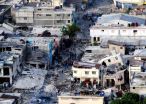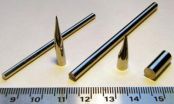(Press-News.org) A new assessment of global earthquake fatalities over the past three decades indicates that 83 percent of all deaths caused by the collapse of buildings during earthquakes occurred in countries considered to be unusually corrupt.
Authored by Professor Nicholas Ambraseys of the Imperial College of London and Professor Roger Bilham of the University Colorado at Boulder, the study also found that in some relatively wealthy countries where knowledge and sound business practices would be expected to prevail, the collapse of many buildings is nevertheless attributable to corrupt building practices.
A commentary piece on the subject is being published in the Jan. 13 issue of Nature.
Corrupt building practices -- which are generally covert and hard to quantify -- can include the use of substandard materials, poor assembly methods, the inappropriate placement of buildings and non-adherence to building codes, said the authors.
Ambraseys and Bilham used data gathered by Transparency International, a global organization based in Berlin that operates through more than 70 national chapters around the world. Transparency International annually generates a Corruption Perception Index, or CPI, as determined by expert assessments and opinion surveys.
The CPI index -- which defines corruption as the abuse of entrusted power for private gain -- is determined by an aggregate of 13 opinion polls averaged over two years from 10 institutions monitoring the frequency and extent of bribes paid within various countries, said Bilham, a professor in CU-Boulder's geological sciences department. A CPI score of 0 indicates a highly corrupt nation with zero transparency, while a score of 10 indicates an absence of perceived corruption with total transparency.
The authors determined that there is roughly a one-to-one relationship between a nations' wealth and its perceived level of corruption. "Less wealthy nations are the most corrupt," said Bilham, also a fellow in the CU-Boulder based Cooperative Institute for Research in Environmental Sciences. "We found that fully 83 percent of all deaths from earthquakes in the last 30 years have occurred in nations where corruption is both widespread and worse than expected."
Relative wealth is the most obvious parameter that influences a country's corruption, according to the authors. Bilham and Ambraseys chose the gross national income per capita to compare the relative wealth of the countries. High wealth is strongly linked to countries with a stable government conducive to the rule of law, they said.
The authors noted that while a 7.0 magnitude earthquake that struck in New Zealand in 2010 resulted in zero fatalities, an identical 2010 quake in Haiti resulted in a death toll reaching six figures. "Widespread anecdotal evidence points to the collapse of structures in devastating earthquakes as a result of corrupt building practices," said Bilham. "In this study we have attempted to quantify that perception.
"Corruption is found to be far worse in some countries than others, despite a measure of wealth that tells us they should do better," said Bilham. "It is in the countries that have abnormally high levels of corruption where we find most of the world's deaths from earthquakes."
The global construction industry, currently worth $7.5 trillion annually and which is expected to double in the next decade, is recognized by experts as being the most corrupt segment of the world economy, said the authors.
Since 1980, deaths due to an absence of effective earthquake engineering activity have averaged about 18,300 per year, according to the authors.
Poverty and poor education also contribute to building collapse through a lack of strong, available building materials and a lack of education that otherwise would help guide safe building practices, the authors said.
The number of deaths attributable to collapsed dwellings is influenced both by the population density and the vulnerability of buildings near earthquake epicenters, said the authors. In the past 30 years, the rapid increases in urban populations -- particularly in developing countries -- have been adversely affected by building quality.
The authors said even if corrupt building practices were halted today, those residing in impoverished nations would inherit at least some structures and dwellings that were constructed while corrupt construction practices were under way.
"The structural integrity of a building is no stronger than the social integrity of the builder, and each nation has a responsibility to its citizens to ensure adequate inspection," the authors wrote in Nature. "In particular, nations with a history of significant earthquakes and known corruption issues should stand reminded that an unregulated construction industry is a potential killer."
INFORMATION:
Extent of corruption in countries around the world tied to earthquake fatalities
2011-01-13
ELSE PRESS RELEASES FROM THIS DATE:
The quest for rat poisons that mimic the Pied Piper's magic flute
2011-01-13
Scientists dream of developing a real-world version of the Pied Piper's magic flute — new poisons that pose no threat to people, pets or wildlife, while specifically targeting rats, those germ-laden creatures that outnumber humans 6 to 1 in some urban areas. An article in the current edition of Chemical & Engineering News (C&EN), ACS' weekly newsmagazine, details some of the steps toward that goal.
C&EN Associate Editor Jyllian Kemsley points out that rats not only are notorious carriers of infectious disease, but threaten the survival of native plants and wildlife. ...
Elastography helps identify patients who need biopsy
2011-01-13
A new ultrasound technique is proving valuable in distinguishing malignant from benign breast lesions in some patients – results that could mean fewer unnecessary breast biopsies, a new study shows.
The study found that ultrasound elastography, which indicates tissue softness, can help predict cancer in patients with BI-RADS category 4 masses. "Because malignant tumors predominantly are harder than benign tissues, this technique significantly improves the differentiation between benign and malignant tissue" said Hiroko Satake, MD, lead author of the study. Dr. Satake ...
Preoperative breast MRI suggests high cancer yield
2011-01-13
The use of preoperative Breast MRI detects otherwise occult cancer with a relatively high degree of accuracy when applied to a diverse population of patients newly diagnosed with breast cancer, according to a study in the January issue of the American Journal of Roentgenology.
The study was performed at the University of Washington and Seattle Cancer Care Alliance in Seattle, WA.
The review initiated with 592 patients who were recently diagnosed with breast cancer and underwent staging with preoperative breast MRI. The analysis set was comprised of 570 patients, whose ...
UBC-VCH researchers find critical link between Down syndrome and Alzheimer's disease
2011-01-13
Researchers at the University of British Columbia and Vancouver Coastal Health Research Institute have discovered that the genetic mechanism which destroys brain cells is responsible for early development of Alzheimer's Disease in people with Down Syndrome and for development of Alzheimer's Disease in general population – providing a potential new target for drugs that could forestall dementia in people with either condition.
The research, led by Dr. Weihong Song, Canada Research Chair in Alzheimer's Disease and a professor of psychiatry in the UBC Faculty of Medicine, ...
How children cope with the aftermath of a hurricane
2011-01-13
CORAL GABLES, FL (January 12, 2011) --Living through a natural disaster is a traumatic experience for everyone, but especially for children. A new study by University of Miami Psychologist Annette La Greca and her collaborators, indicate that some children who directly experience a devastating hurricane still show signs of posttraumatic stress (PTS) almmost two years after the event. The findings suggest that new models for intervention to help children after a natural disaster are needed.
The study, titled "Hurricane-Related Exposure Experiences and Stressors, Other Life ...
Middle school is when the right friends may matter most
2011-01-13
EUGENE, Ore. -- (Jan. 12, 2011) -- As adolescents move from elementary school into their middle or junior-high years, changes in friendships may signal potential academic success or troubles down the road, say University of Oregon researchers.
A new study, appearing in the February issue of the Journal of Early Adolescence, found that boys and girls whose friends are socially active in ways where rules are respected do better in their classroom work. Having friends who engage in problem behavior, in contrast, is related to a decrease in their grades. Having pro-social ...
Attention ladies and gentlemen: Courtship affects gene expression
2011-01-13
Scientists from Texas have made an important step toward understanding human mating behavior by showing that certain genes become activated in fruit flies when they interact with the opposite sex. This research, published in the January 2011 issue of the journal GENETICS (http://www.genetics.org), shows that courtship behaviors may be far more influenced by genetics than previously thought. In addition, understanding why and how these genes become activated within social contexts may also lead to insight into disorders such as autism.
"Be careful who you interact with," ...
Caltech-led team creates damage-tolerant metallic glass
2011-01-13
PASADENA, Calif.—Glass is inherently strong, but when it cracks or otherwise fails, it proves brittle, shattering almost immediately. Steel and other metal alloys tend to be tough—they resist shattering—but are also relatively weak; they permanently deform and fail easily.
The ideal material, says Marios Demetriou, a senior research fellow at the California Institute of Technology (Caltech), has the advantage of being both strong and tough—a combination called damage tolerance, which is more difficult to come by than the layperson might think. "Strength and toughness ...
23andMe presents top 10 most interesting genetic findings of 2010
2011-01-13
MOUNTAIN VIEW, CA – January 11, 2011 – 23andMe has released its first annual list of what it felt to be the 10 most interesting and significant genetic findings in 2010, as part of an ongoing journey to understand the role of genetics in personal health and human development.
"Our understanding of the human genome is accelerating at a phenomenal rate," stated Anne Wojcicki, co-founder and CEO of 23andMe. "Below we have compiled a list of our top ten favorite genetic discoveries from 2010. We look forward to exploring more discoveries in 2011."
Customers of 23andMe ...
New method will triple amount of genetic information from newborn blood spot screenings
2011-01-13
Grand Rapids, Mich. (January 12, 2011) – Van Andel Research Institute (VARI) researchers have developed a method that can yield more information from archived newborn blood that has implications for a vast array of research, including population health studies and answering questions about diseases in infants and children.
In a recent study published in Pathology International, VARI researchers detected approximately 9,000 activated genes in samples from adult blood spots on Guthrie cards that had been archived anywhere from six months to three years. Researchers say ...



